Secrets of caring for tomatoes in the open field: rules for growing street tomatoes
Certainly growing tomatoes indoors is easier (more precisely, more favorable conditions can be created there). However, if your greenhouse is busy with cucumbers (although these crops can be grown quite successfully under one polycarbonate roof) either you do not have it, or you are a resident of the southern region - in any case, you can get a decent harvest of tomatoes in the open field, the differences in care are not so fundamental.
Next, we will talk in detail about the features of the agricultural technology of growing tomatoes in the open field, touch on the nuances of watering, feeding, tying and forming bushes (including pinching), as well as the protection and control of diseases and pests.
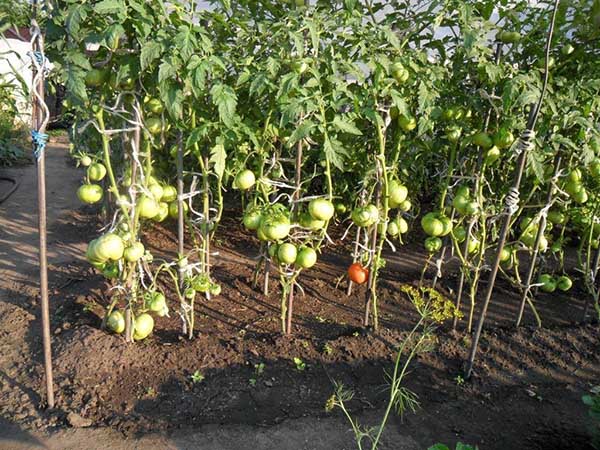
Content
Terms and rules for planting tomato seedlings in open ground
Of course, in order for the tomatoes to initially take root well in a new place, they need to be planted in open ground (at the right distance) when the soil and ambient air are warm enough.
Advice! The site already has detailed material about when and how to properly plant tomato seedlings in open ground.
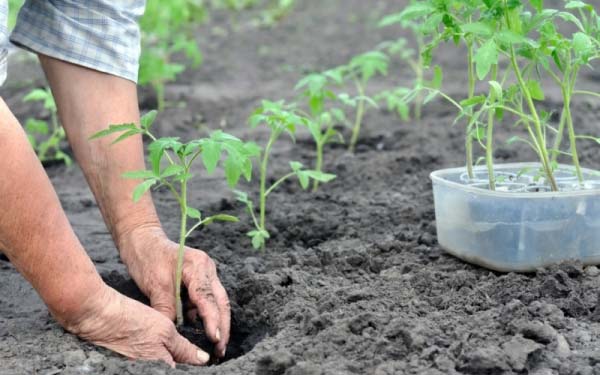
How to properly care for tomatoes in the open field: basic activities and growing rules
The list of the main agronomic measures for caring for tomatoes in the open field, as a rule, includes the following:
- watering;
- loosening and weeding (depending on the presence or absence of mulch):
- mulching (optional, but highly desirable);
- top dressing;
- garter (if necessary);
- formation (optional);
- pinching;
- protection against pests and diseases (more precisely, the fight against them).
Watering
After you plant the tomatoes in the garden, for the first time (5-7 days after transplanting) it is better not to touch them (do not water, do not tie, do not feed), but give time to settle down in a new place (recover from stress).
By the way! Discover all the subtleties of watering tomatoes you can after reading this article.
Then they will need abundant but not frequent watering, approximately every week (5-7 days).
Basic rules for watering tomatoes in the open field:
- In greenhouse conditions, moisture does not evaporate from the soil as quickly as under the open sun (especially in summer heat and drought), which means watering tomatoes growing outdoors should be done more oftenthan in a greenhouse (it's another matter if it rains frequently: then you have to act according to the situation).
- About the most suitable time of day for watering tomatoes, there is still controversy. Some gardeners believe that it is better to do this. in the evening, others - in the morning (in the first half of the day).
Advice! More about when (at what time of day) and how best to water tomatoes, read in this article.
- Concerning irrigation techniques, then tomatoes should only be watered under the root - by no means by means of sprinkling, which can simply lead to plant disease.
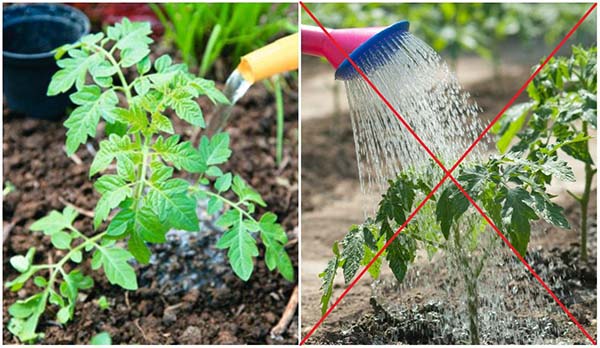
Note! Improper irrigation technique, rare or, on the contrary, excessively abundant watering (overflow) can lead to such negative consequences as cracking tomato fruit, rolling leavesand also todisease of tomato bushes with late blight.
- If you decide not to mulch the beds (and in vain!), Then do not forget after each watering loosen the ground around the seedlings (to restore oxygen access to the roots, since an earthen crust often forms after watering) and weed them from the weeds.
Mulching
If you do not want to engage in frequent loosening and wateringthen just mulch their tomato beds. Thanks to this, you can reduce the number of wateringsbecause the mulch will prevent moisture from evaporating quickly and the soil will stay moist longer.
Important! It is undesirable to mulch the bushes immediately after planting the seedlings. It is recommended to wait a couple of weeks for the tomatoes to take root and the weather becomes warmer (after all, mulch makes the microclimate around tomatoes more humid and cool).
You can use mowed lawn grass as mulch, straw and hay (perfect for undersized varieties of tomatoes), compost, humus, peat, sawdust and wood chips.
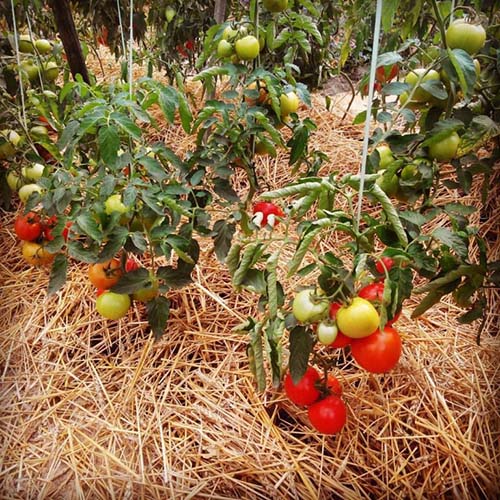
Video: how you can mulch tomatoes in the open field
Top dressing
They begin to feed the tomatoes 10-14 days after planting the seedlings in the garden. As a rule, the following feeding scheme is used (according to the stages of plant development):
However! If you originally filled the soil with all the nutrients during the preparation of the garden (or put it in the hole), then most likely you will not need any additional fertilizing (except for potash during the fruiting period). In this case, you need to feed only when necessary, if the plant suddenly starts signaling that it is missing something.
By the way! The site has a separate detailed article about how and how to feed tomatoes in a greenhouse after planting, during flowering and during active fruiting (for open ground everything is the same).
- The first feeding of tomatoes after planting in the ground (before flowering) - plants need more nitrogen... Moreover, several such dressings can be made (before flowering).
- The next stage of development — the beginning of flowering and the period of budding (fruit setting)... During this period, the plant needs nitrogen (but less), as well as potassium, phosphorus and boron... Those. you need a complex fertilizer (such as nitroammophoska).
Advice! To improve fruit setting (stimulation of ovaries), including in unfavorable weather conditions (in heat or cold), acceleration of obtaining and increasing yields, during flowering it is recommended that foliar feeding (spraying over the leaves). For example, a solution is suitable for this boric acid (powder) or special preparations, such as "Tomaton" or "Ovary" (it happens like for tomatoes, So universal - for all cultures).
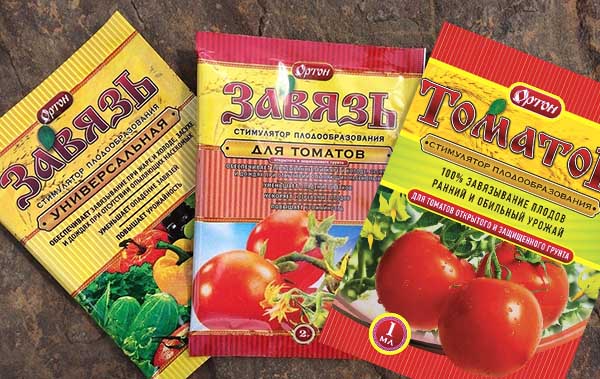
- The third stage of tomato development - initial phase of fruiting. The plant at this moment needs more potassium... Suitable for this ash solution, potassium sulfate. A phosphorus will never be superfluous!
And 2-3 weeks before the reddening of the tomatoes, be sure to feed calcium nitrate against top rot of tomato fruit - on the leaves (i.e. spraying).
- The fourth phase - active fruiting... Again a lot of potassium, you can have a little nitrogen and phosphorus. For example, give one top dressing with potassium nitrate, and then use only potash fertilizers (you can potassium-phosphorus, such as potassium monophosphate).
Advice! Once again, we recommend that you familiarize yourself with this detailed guide on how to feed tomatoes in the greenhouse throughout their growing season (for open ground everything is the same).
Garter
Many varieties of tomatoes, especially tall (indeterminate)need a binding garter. However, in the open field they are more often grown undersized (determinant) varieties of tomatoes, but they usually have to be tied up (except dwarf and standard - super-determinant varieties).
By the way! The site already has an article that describes in detail about rules and methods of garter tomatoes in the open field.
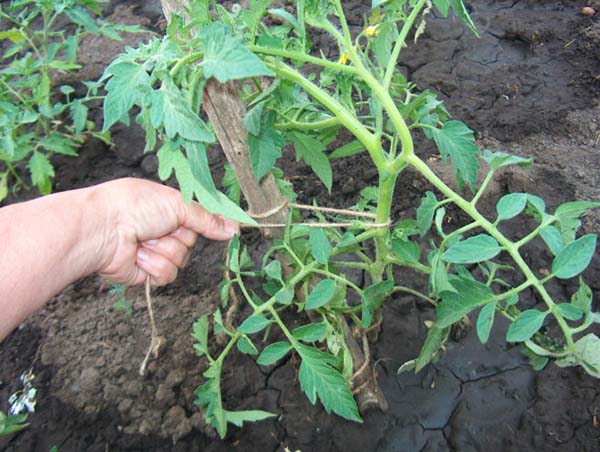
Formation of bushes: pinching, removing excess leaves and pinching the tops
So, the formation of tomato bushes includes the following main agrotechnical measures:
- pinning (removing stepsons);
- removal of excess (lower) leaves;
- pinching of growth points (stem tops).
By the way! The site has a separate detailed article about how to shape tomatoes.
Briefly about the formation of bushes in 1 and 2 stems
The essence of the formation of tomatoes in the open field is reduced to growing tomatoes in 1 (more often) or 2 stems (less often) and leaving a different number of fruit brushes, depending on from the type.
- So, indeterminate (tall) tomatoes in the open field always form in 1 stem, removing all the stepsons, while pinching above the leaf after 5 fruit cluster;
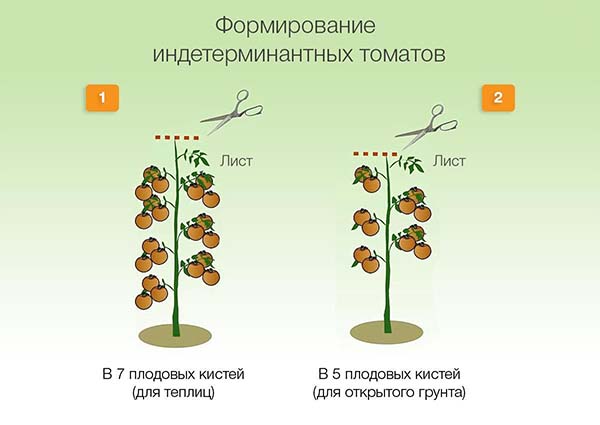
- determinant (undersized) tomatoes in the open field, they are also formed into 1 stem (but it is also possible in 2);
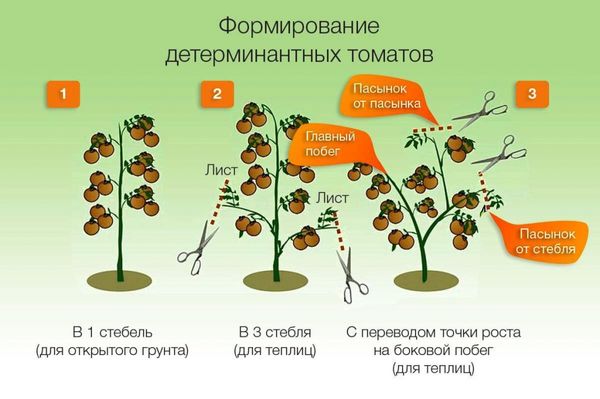
- and here superdeterminant (dwarf) varieties in the open fieldform into 2 stems (in rare cases in 3).
By the way! It is dwarf standard tomatoes that can not be formed at all, because they themselves do not give many stepsons, and if they do, then just within 2-3.
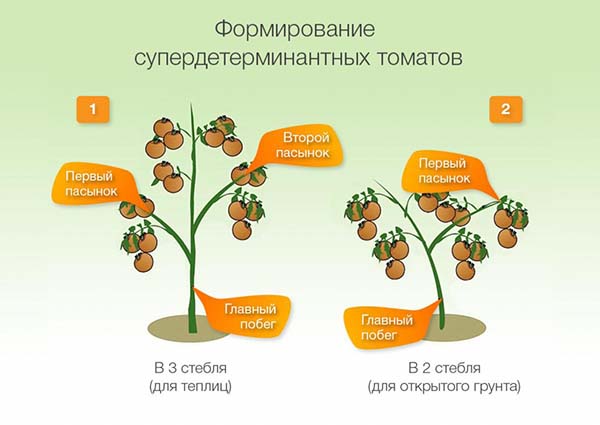
Advice! More about how to form tomatoes in 1 and 2 stems in the open field, told in this material.
Briefly about pinning
Over time, stepchildren begin to appear in tomatoes. They are absolutely useless, but the plants spend energy on them, because of which they themselves weaken and slow down in growth (this also applies to fruiting). Therefore, it is recommended to carry out weekly pinching of tomatoes.
You don't need scissors or pruning shears to do this. It is much more convenient and correct to remove stepchildren with the index and thumb. Moreover, it is imperative to leave a small stump (somewhere 0.5-1 cm) so that a new stepson does not appear in this place soon.
By the way! More about pinching tomatoes read in this article.
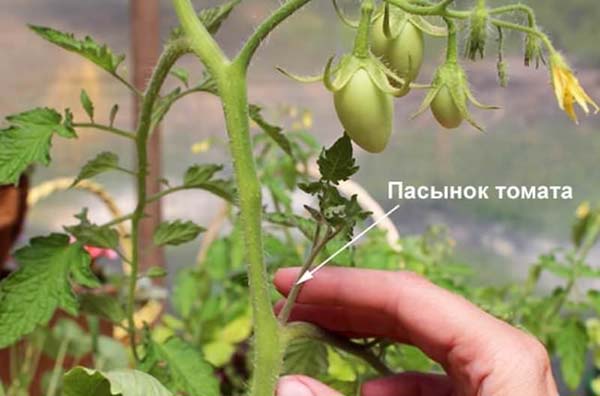
Removing the lower leaves
The purpose of removing the lower leaves is to keep the tomato bushes well ventilated (for better airflow). Eit will have a positive effect on decreasing probability appearance phytophthoraand will also be open greatlight access to the lower fruits (they will ripen faster).
Leaves are removed only if when the fruits begin to form... Moreover, the leaves are removed no more than 1-2 pieces per week, but in no case 3-5 at a time, otherwise the plant will be in a state of shock.
However! It is believed that in the open field it is undesirable to remove the leaves that cover the fruits, otherwise they (tomatoes) can be burned by the sun.
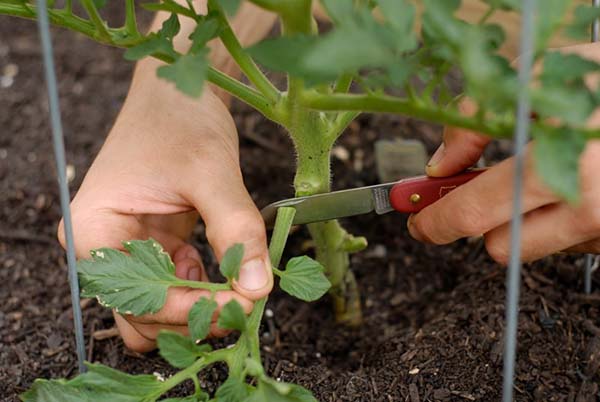
Briefly about pinching the growth point
When growing indeterminate (tall) It is very important to pinch the top of tomatoes in a timely manner (after the last fruit brush, leaving 2-3 leaves above it) in order to stop the growth of the bushes up. If it's on time (late July-early August) do not do then tomatoes, which will tie at the top of the bush, simply will not have time to ripen.
Note! More about when and how to trim the leaves and pinch the tops, told in this general article on forming tomato bushes.
Diseases and pests of tomatoes
Tomatoes outdoors are susceptible to fungal diseases such as:
- late blight;
This is one of the most common and dangerous fungal diseases, so the fight against late blight is dedicated a whole separate article.
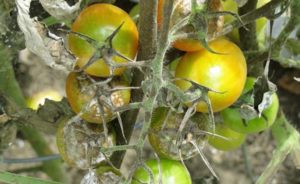
- various spots: brown spot (cladosporium), gray spot, etc.
- various rot (stem, root, vertex, gray, brown or fomoz, etc.);
- blackleg (more relevant for the seedling period);
- powdery mildew and etc.
By the way! The main cause of most fungal diseases of tomatoes is high humidity (this especially concerns the appearance phytophthora). Therefore, to prevent it, one should water the tomatoes correctly and don't forget trim the bottom leavesso that the bushes do not thicken.
Remember! Pruning leaves is included in one of the activities on the formation of tomato bushes.
Besides, viral (mosaic, and infectious chlorosis that is carried by the whitefly) and bacterial (special bacterial cancer) diseases.
By the way! If your tomatoes have curled leaves, this does not mean that they are sick with something.
More details about the reasons why the leaves of tomatoes can curl, you can find in this article.
Alternatively, for the preventive protection of tomatoes from diseases, you can prepare a tank mixture based on biological drugs such as Gamair and Alirin (as well as Fitosporin). And Glyocladin (1 tablet) can simply be buried 2-3 cm into the soil, stepping back 5 cm from the plant (when planting seedlings in the ground).
Remember! A disease or pest attack is always easier to prevent than to deal with directly. Therefore, do not neglect preventive treatments for tomato bushes.
As for pests, the main enemies of tomatoes are:
- bear;
Important! The site has a detailed article about how to deal with a bear in the garden.
- nematode;
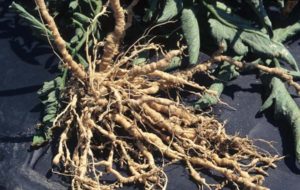
- aphid;
- spider mite;
- gnawing scoops;
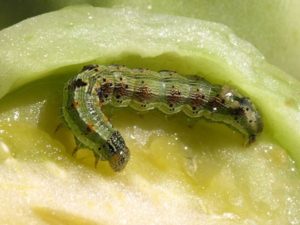
- greenhouse whitefly.
However! The most dangerous pest tomato in the greenhouse is an whitefly, although in the open field, she usually not raging (wrong conditions).
Video: diseases and pests of tomatoes
Tomato care in autumn (in September)
In general, all autumn tomato care comes down to getting a residual crop. Namely, so that it has time to ripen while the weather is still relatively warm. For this use special techniques to accelerate the ripening of fruits on the bush.
By the way! The site has an article about how to care for tomatoes in September to ripen the remaining crop.
Harvesting
Advice! You need to collect tomatoes in a timely manner: If you leave the lower, already ripe tomatoesthen they are simply will not ripen the top (will delay their maturity).
Depending on the degree of ripeness, tomatoes are used for different purposes:
- green - for long-term storage and ripening;
- dairy, brown and pink (blanche ripeness) - for pickling, pickling and canning, as well as for ripening;
About the methods of ripening tomatoes at home detailed in this article.
- red - used directly for food or for making tomato juice or paste.
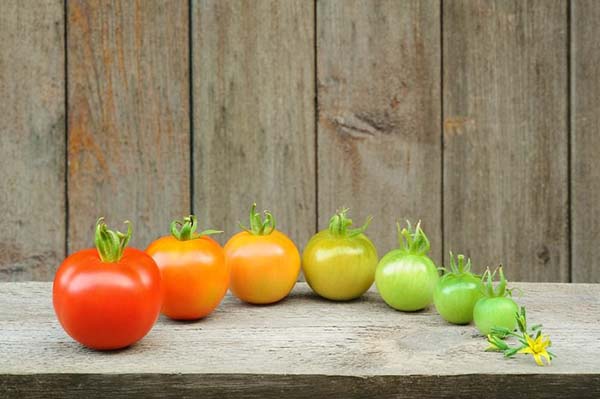
After you harvest the last tomato crop in September-October, you will need clean the greenhouse from plant residues, rinse thoroughly and process.
By the way! The site has a detailed article about how to carry out the autumn processing of the greenhouse after harvest and how to prepare it for winter.
Well, now you know how to care for tomatoes outdoors to get a rich harvest. All agrotechnical techniques are fairly standard, except for surgical ones, which means that there should not be any special difficulties with their correct implementation. However, theory without practice is nothing, so let's go to the garden!

